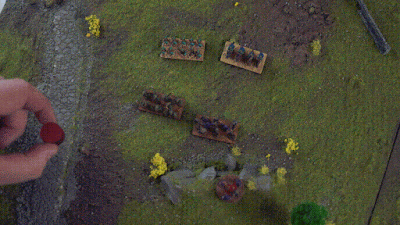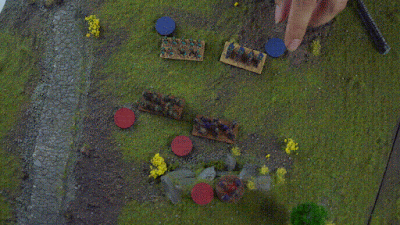24 Oct 2018
The Game Mechanics of Mythos of Legends
The game works entirely on four different stats, Wrath (used for close combat attacks), Wisdom (used for shooting attacks and morale), Swiftness (used for movement and charging) and Determination (used for saves and wounds). The score needed for success on any die when making a check against one of these stats is given by the deity’s profile, so for example a player with Odin will pass Wisdom checks more easily, while by contrast a player with Thor will struggle with Wisdom but will pass Wrath checks more easily.
The unit’s stats give the number of six-sided dice that you roll, with each one passing on the value indicated by the deity. So, for example a player makes a Wisdom check where their unit’s stats give them 6 dice, and they might need 3 of those rolls to be successes to pass the check as a whole.
A roll is a success if it passes the target score given by their deity model. For example, if a unit of Deep One Hybrids under the patronage of Cthulhu had to undertake a swiftness test, they would begin with four dice. For a swiftness check die to considered successful, the number shown on the die would have to be a 4, 5 or 6; since Cthulhu’s target score is “4+”
The number of dice being rolled in a check may be affected in a number of ways, including the special rules and equipment that are attached to the unit. For example, whilst the Deep One Hybrids above have a determination value of “2”, they also have “Armour [2]” listed within their equipment. This rule means that if the Deep One Hybrids are forced to take a determination save after being attacked, they add two extra dice to the check roll and as such would roll four dice, with a roll of a 4, 5 or 6 being considered successful due to the target score set by Cthulhu.
In addition to determining what the player needs to roll to pass each die, the deity can also add or take away dice from the roll by moving around the mythos board. Each side of the board is labelled with one of the four stats. Wrath and Wisdom sit opposite one another, as do Swiftness and Determination. If the deity is right next to one board edge, say Swiftness, all stat checks involving Swiftness gain 2 extra dice. But because the deity is as far away as they can get from Determination, all stat checks involving Determination lose 2 dice. If the player moves one square away from Swiftness, they instead gain 1 extra die to Swiftness checks and lose 1 from Determination checks. The next square takes them closer to Determination and the relationship flips over, and so on. There is no central position, which means that the player’s deity must always be positioned to boost two stats and take away from the other two. This means that from turn to turn the players need to think carefully about which stats will be most important to their army and position their deity appropriately.
The game uses alternating activations and a priority system. At the start of every turn, players roll off for priority with the player who scores highest getting to go first in every part of the turn. Generally the player with priority carries out one action, then their opponent, then back and forth until both players have exhausted their actions in that part of the game turn.
Once priority has been determined, play enters the Mythos Phase. This is the main phase for the deities to attempt to influence the battle. The players must move their deity to a different square on the mythos board every turn, which prevents players finding the ‘best’ square and camping on it for the length of the game.
This phase also gives the players the chance to attempt Divine Intervention, which where the gods attempt to exert even more influence on the game. Each player is given four ‘Divine Dice’ which they can use to roll for divine interventions, or can save to use later in the turn by adding them to any stat check that they want to. Each deity has three divine interventions on their profile which are written to be interesting, diverse and tailored to match the legends and personality of that deity. This adds some mythic flavour to the match by, for example, allowing Zeus to hurl a thunderbolt at the battlefield, Loki to steal divine dice from his opponent or Nyarlathotep to spread madness around the mortal soldiers fighting in his name. These kick in from the second turn onwards, one of the measures adopted to prevent players from trying to ‘alpha strike’ their opponents’ units off the board before they have had a chance to do anything.
After divine interventions, the game moves to the Orders Phase. Players issue orders to their soldiers in the form of Mythos Obols, tokens which have identical backs and order symbols on their face. They are chosen in secret and placed face-down next to their assigned unit. This means that even though activations alternate, the actual actions that the units will carry out are somewhat locked-down by the state of the battlefield at this point in time. This requires strategic thinking on the part of the players since they know that some of their units which activate early will be faced with a battlefield looking largely as it does at the point they issued the orders, while the units which activate later might be faced with a different scene after most of the other units have carried out their actions.
Players can issue orders to March (move quickly), Release (make a shooting attack), Charge (charge into combat with an enemy) or Command (issue commands to other units with generals and officers). Some units can also use a Mythic Action order, which is usually a unique ability listed on their profile. Many legendary units have Mythic Actions, but some regular units do too.
Once both players have secretly issued all of their orders, the game moves to the Activation Phase. The player with priority chooses the first unit to activate, reveals the order on its Mythos obol and carries it out. Play then passes to their opponent and back and forth until all orders have been completed.
Finally play passes to the Resolution Phase where players determine combat resolution and roll break checks for losers, clear away any in-game effects from earlier in the turn and determine if victory conditions have been met dependent on the scenario being played.
The World of Lardello
Subscribe to:
Post Comments (Atom)









No comments:
Post a Comment